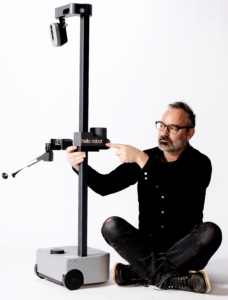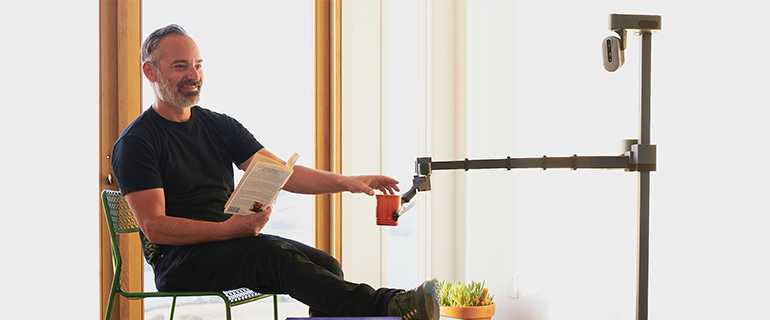Ex-Googler’s Startup Comes Out of Stealth With Beautifully Simple, Clever Robot Design
By Evan Ackerman and Erico Guizzo
Over the last 10 years, the PR2 has helped roboticists make an enormous amount of progress in mobile manipulation over a relatively short time. I mean, it’s been a decade already, but still—robots are hard, and giving a bunch of smart people access to a capable platform where they didn’t have to worry about hardware and could instead focus on doing interesting and useful things helped to establish a precedent for robotics research going forward.
Unfortunately, not everyone can afford an enormous US $400,000 robot, and even if they could, PR2s are getting very close to the end of their lives. There are other mobile manipulators out there taking the place of the PR2, but so far, size and cost have largely restricted them to research labs. Lots of good research is being done, but it’s getting to the point where folks want to take the next step: making mobile manipulators real-world useful.
Today, a company called Hello Robot is announcing a new mobile manipulator called the Stretch RE1. With offices in the San Francisco Bay Area and in Atlanta, Ga., Hello Robot is led by Aaron Edsinger and Charlie Kemp, and by s
To understand the concept behind Stretch, it’s worth taking a brief look back at what Edsinger and Kemp have been up to for the past 10 years. Edsinger co-founded Meka Robotics in 2007, which built expensive, high-performance humanoid arms, torsos, and heads for the research market. Meka was notable for being the first robotics company (as far as we know) to sell robot arms that used series elastic actuators, and the company worked extensively with Georgia Tech researchers. In 2011, Edsinger was one of the co-founders of Redwood Robotics (along with folks from SRI and Willow Garage), which was going to develop some kind of secret and amazing new robot arm before Google swallowed it in late 2013. At the same time, Google also acquired Meka and a bunch of other robotics companies, and Edsinger ended up at Google as one of the directors of its robotics program, until he left to co-found Hello Robot in 2017.
Meanwhile, since 2007 Kemp has been a robotics professor at Georgia Tech, where he runs the Healthcare Robotics Lab. Kemp’s lab was one of the 11 PR2 beta sites, giving him early experience with a ginormous mobile manipulator. Much of the research that Kemp has spent the last decade on involves robots providing assistance to untrained users, often through direct physical contact, and frequently either in their own homes or in a home environment. We should mention that the Georgia Tech PR2 is still going, most recently doing some clever material classification work in a paper for IROS later this year.
 So with all that in mind, where’d Hello Robot come from? As it turns out, both Edsinger and Kemp were in Rodney Brooks’ group at MIT, so it’s perhaps not surprising that they share some of the same philosophies about what robots should be and what they should be used for. After collaborating on a variety of projects over the years, in 2017 Edsinger was thinking about his next step after Google when Kemp stopped by to show off some video of a new robot prototype that he’d been working on—the prototype for Stretch. “As soon as I saw it, I knew that was exactly the kind of thing I wanted to be working on,” Edsinger told us. “I’d become frustrated with the complexity of the robots being built to do manipulation in home environments and around people, and it solved a lot of problems in an elegant way.”
So with all that in mind, where’d Hello Robot come from? As it turns out, both Edsinger and Kemp were in Rodney Brooks’ group at MIT, so it’s perhaps not surprising that they share some of the same philosophies about what robots should be and what they should be used for. After collaborating on a variety of projects over the years, in 2017 Edsinger was thinking about his next step after Google when Kemp stopped by to show off some video of a new robot prototype that he’d been working on—the prototype for Stretch. “As soon as I saw it, I knew that was exactly the kind of thing I wanted to be working on,” Edsinger told us. “I’d become frustrated with the complexity of the robots being built to do manipulation in home environments and around people, and it solved a lot of problems in an elegant way.”
For Kemp, Stretch is an attempt to get everything he’s been teaching his robots out of his lab at Georgia Tech and into the world where it can actually be helpful to people. “Right from the beginning, we were trying to take our robots out to real homes and interact with real people,” says Kemp. Georgia Tech’s PR2, for example, worked extensively with Henry and Jane Evans, helping Henry (a quadriplegic) regain some of the bodily autonomy he had lost. With the assistance of the PR2, Henry was able to keep himself comfortable for hours without needing a human caregiver to be constantly with him. “I felt like I was making a commitment in some ways to some of the people I was working with,” Kemp told us. “But 10 years later, I was like, where are these things? I found that incredibly frustrating. Stretch is an effort to try to push things forward.”
A robot you can put it in the backseat of a car
One way to put Stretch in context is to think of it almost as a reaction to the kitchen sink philosophy of the PR2. Where the PR2 was designed to be all the robot anyone could ever need (plus plenty of robot that nobody really needed) embodied in a piece of hardware that weighs 225 kilograms and cost nearly half a million dollars, Stretch is completely focused on being just the robot that is actually necessary in a form factor that’s both much smaller and affordable. The entire robot weighs a mere 23 kg in a footprint that’s just a 34 cm square. As you can see from the video, it’s small enough (and safe enough) that it can be moved by a child. The cost? At $17,950 apiece—or a bit less if you buy a bunch at once—Stretch costs a fraction of what other mobile manipulators sell for.
It might not seem like size or weight should be that big of an issue, but it very much is, explains Maya Cakmak, a robotics professor at the University of Washington, in Seattle. Cakmak worked with PR2 and Henry Evans when she was at Willow Garage, and currently has access to both a PR2 and a Fetch research robot. “When I think about my long term research vision, I want to deploy service robots in real homes,” Cakmak told us. Unfortunately, it’s the robots themselves that have been preventing her from doing this—both the Fetch and the PR2 are large enough that moving them anywhere requires a truck and a lift, which also limits the home that they can be used in. “For me, I felt immediately that Stretch is very different, and it makes a lot of sense,” she says. “It’s safe and lightweight, you can probably put it in the backseat of a car.” For Cakmak, Stretch’s size is the difference between being able to easily take a robot to the places she wants to do research in, and not. And the cost is a factor as well since a cheaper robot means more access for her students. “I got my refurbished PR2 for $180,000,” Cakmak says. “For that, with Stretch, I could have 10!”
Of course, a portable robot doesn’t do you any good if the robot itself isn’t sophisticated enough to do what you need it to do. Stretch is certainly a compromise in functionality in the interest of small size and low cost, but it’s a compromise that’s been carefully thought out, based on the experience that Edsinger has building robots and the experience that Kemp has operating robots in homes. For example, most mobile manipulators are essentially multi-degrees-of-freedom arms on mobile bases. Stretch instead leverages its wheeled base to move its arm in the horizontal plane, which (most of the time) works just as well as an extra DoF or two on the arm while saving substantially on weight and cost. Similarly, Stretch relies almost entirely on one sensor, an Intel RealSense D435i on a pan-tilt head that gives it a huge range of motion. The RealSense serves as a navigation camera, manipulation camera, a 3D mapping system, and more. It’s not going to be quite as good for a task that might involve fine manipulation, but most of the time it’s totally workable and you’re saving on cost and complexity.
 Stretch has been relentlessly optimized to be the absolute minimum robot to do mobile manipulation in a home or workplace environment. In practice, this meant figuring out exactly what it was absolutely necessary for Stretch to be able to do. With an emphasis on manipulation, that meant defining the workspace of the robot, or what areas it’s able to usefully reach. “That was one thing we really had to push hard on,” says Edsinger. “Reachability.”
Stretch has been relentlessly optimized to be the absolute minimum robot to do mobile manipulation in a home or workplace environment. In practice, this meant figuring out exactly what it was absolutely necessary for Stretch to be able to do. With an emphasis on manipulation, that meant defining the workspace of the robot, or what areas it’s able to usefully reach. “That was one thing we really had to push hard on,” says Edsinger. “Reachability.”
He explains that reachability and a small mobile base tend not to go together because robot arms (which tend to weigh a lot) can cause a small base to tip, especially if they’re moving while holding a payload. At the same time, Stretch needed to be able to access both countertops and the floor, while being able to reach out far enough to hand people things without having to be right next to them. To come up with something that could meet all those requirements, Edsinger and Kemp set out to reinvent the robot arm.
Stretch’s key innovation: a stretchable arm
The design they came up with is rather ingenious in its simplicity and how well it works. Edsinger explains that the arm consists of five telescoping links: one fixed and four moving. They are constructed of custom carbon fiber and are driven by a single motor, which is attached to the robot’s vertical pole. The strong, lightweight structure allows the arm to extend over half a meter and hold up to 1.5 kg. Although the company has a patent pending for the design, Edsinger declined to say whether the links are driven by a belt, cables, or gears. “We don’t want to disclose too much of the secret sauce [with regard to] the drive mechanism.” He added that the arm was “one of the most significant engineering challenges on the robot in terms of getting the desired reach, compactness, precision, smoothness, force sensitivity, and low cost to all happily coexist.”
Another interesting feature of Stretch is its interface with the world—its gripper. There are countless different gripper designs out there, each and every one of which is the best at gripping some particular subset of things. But making a generalized gripper for all of the stuff that you’d find in a home is exceptionally difficult. Ideally, you’d want some sort of massive experimental test program where thousands and thousands of people test out different gripper designs in their homes for long periods of time and then tell you which ones work best. Obviously, that’s impractical for a robotics startup, but Kemp realized that someone else was already running the study for him: Amazon.
“I had this idea that there are these assistive grabbers that people with disabilities use to grasp objects in the real world,” he told us. Kemp went on Amazon’s website and looked at the top 10 grabbers and the reviews from thousands of users. He then bought a bunch of different ones and started testing them. “This one [Stretch’s gripper], I almost didn’t order it, it was such a weird-looking thing,” he says. “But it had great reviews on Amazon, and oh my gosh, it just blew away the other grabbers. And I was like, that’s it. It just works.”






